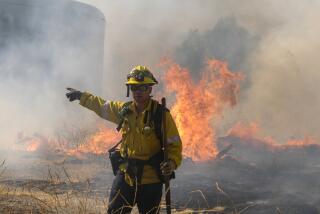California regulator warns about gaps in ride-sharing insurance
SACRAMENTO — A deadly accident involving a California ride-sharing driver has brought to light a potential downside to this new high-tech carpooling: Who pays when something goes wrong?
Companies such as Uber, Lyft and Sidecar have long insisted that the insurance they provide their drivers is sufficient to cover accidents. But a recent tragedy shows the murky legal terrain in which these new taxi-like services operate.
On New Year’s Eve, an Uber driver struck and killed a 6-year-old girl who was crossing a San Francisco street with her family. The driver was not carrying any passengers at the time, so it’s unclear whether Uber would be liable.
According to initial accounts, Uber distanced itself from the fatality, stressing that the driver was not covered by Uber’s policy because he was not carrying an Uber passenger when he struck Sofia Liu and two family members.
Last week the family sued Uber anyway for wrongful death and negligence in San Francisco Superior Court. The lawsuit contends that the driver, Syed Muzzafar, was logged on to the Uber network when he hit the Lius, killing Sofia and injuring her mother and brother. Uber declined to comment on the Lius’ lawsuit.
Ride-sharing firms, dubbed “transportation network companies,” got the green light to legally operate in California in September. These firms connect people who need rides with drivers of their own passenger vehicles via smartphone applications. Operators keep a portion of these fares, which tend to be as much as a third cheaper than those of traditional taxis.
The firms are regulated by the California Public Utilities Commission. As part of the new rules, companies must carry $1 million worth of liability insurance when a privately owned car is being used to carry passengers for a fee. The liability coverage kicks in when damages exceed the limits of a driver’s personal liability policy.
But determining exactly when these drivers and cars are covered by the $1-million policy — and when they are not — could end up being settled in court.
Taxicab operators and drivers, who are opponents and competitors of ride-sharing companies, say Sofia Liu’s death was an insurance catastrophe waiting to happen.
“This poor family will likely suffer the double consequence of having lost their 6-year-old daughter and potentially not getting compensated,” said William Rouse, general manager of Los Angeles Yellow Cab and former president of the Taxicab, Limousine & Paratransit Assn., a trade organization.
“Uber is successfully so far shifting the cost of its business onto the general public,” he said, enabling it to save money and cut fares 30% below those charged by traditional cabs.
Representatives of Uber, Lyft and Sidecar said they comply with the new PUC liability insurance requirements. Lyft said it is working with “leaders in the insurance industry so that they develop additional coverage solutions for our community members.”
Unconvinced that passengers, pedestrians and drivers are sufficiently protected, the state Department of Insurance is calling on the PUC to step in.
The Liu suit could be the first of many coverage disputes involving transportation network companies unless the PUC better defines exactly when a driver is providing ride-sharing services, wrote Jennifer McCune, an insurance department lawyer, in a Jan. 10 letter to PUC President Michael R. Peevey.
Even so, many drivers could wind up getting their personal insurance canceled if they are caught driving people for money, McCune warned.
“Most standard personal auto policies contain exclusions for livery — which essentially means driving for hire,” the state Department of Insurance stressed in a recent notice posted to its website. “You may need to consider buying a commercial policy.”
Commercial coverage is as much as 10 times more expensive than personal auto policies because business driving is riskier than personal auto use, industry experts say.
In its notice to drivers, the Department of Insurance stressed that ride-sharing companies are required to provide coverage for damages to other people and property only when their driver is at fault. Additionally, the PUC does not require that the $1-million policy cover bodily injuries to the ride-sharing driver or damage to his or her vehicle. Passengers also aren’t covered if they suffer injuries caused by other drivers with policies that provide bare-bones coverage or who have no insurance at all.
In her letter to the PUC, McCune urged the commission to alert ride-sharing company drivers to the holes in their coverage.
Sounding those warnings is the Department of Insurance’s job; regulating transportation network companies is the PUC’s domain, said Nancy Kincaid, a spokeswoman for state Insurance Commissioner Dave Jones.
“The commissioner sees his role at this point in making sure consumers are fully aware of their coverage,” she said, “and making sure they understand their coverages and what they need to be fully protected.”
In San Francisco, a spokesman for the taxicab workers’ association called on the PUC to require better insurance coverage for ride-sharing drivers. At minimum, they should be required to carry the same commercial insurance policies as taxi owners, taxi driver Mark Gruberg said.
“This is what we were warning against, this gap in insurance where the personal insurance of the driver won’t apply when he or she is providing commercial transportation,” Gruberg said.
For its part, the PUC plans to monitor the new industry and “will clarify or modify” the commission’s insurance requirements as needed, spokeswoman Terrie D. Prosper said.
Insurers, meanwhile, are talking to the PUC, the Department of Insurance and lawmakers to ensure that all victims of accidents are taken care of properly.
Ride-sharing companies need to be treated like taxis — as commercial operators, said Mark Sektnan, president of the Assn. of California Insurance Cos., a trade group. These firms “need to step up and protect the drivers and their passengers.”
Twitter: @MarcLifsher @sal19
Lifsher reported from Sacramento and Rodriguez from Los Angeles.
More to Read
Inside the business of entertainment
The Wide Shot brings you news, analysis and insights on everything from streaming wars to production — and what it all means for the future.
You may occasionally receive promotional content from the Los Angeles Times.












